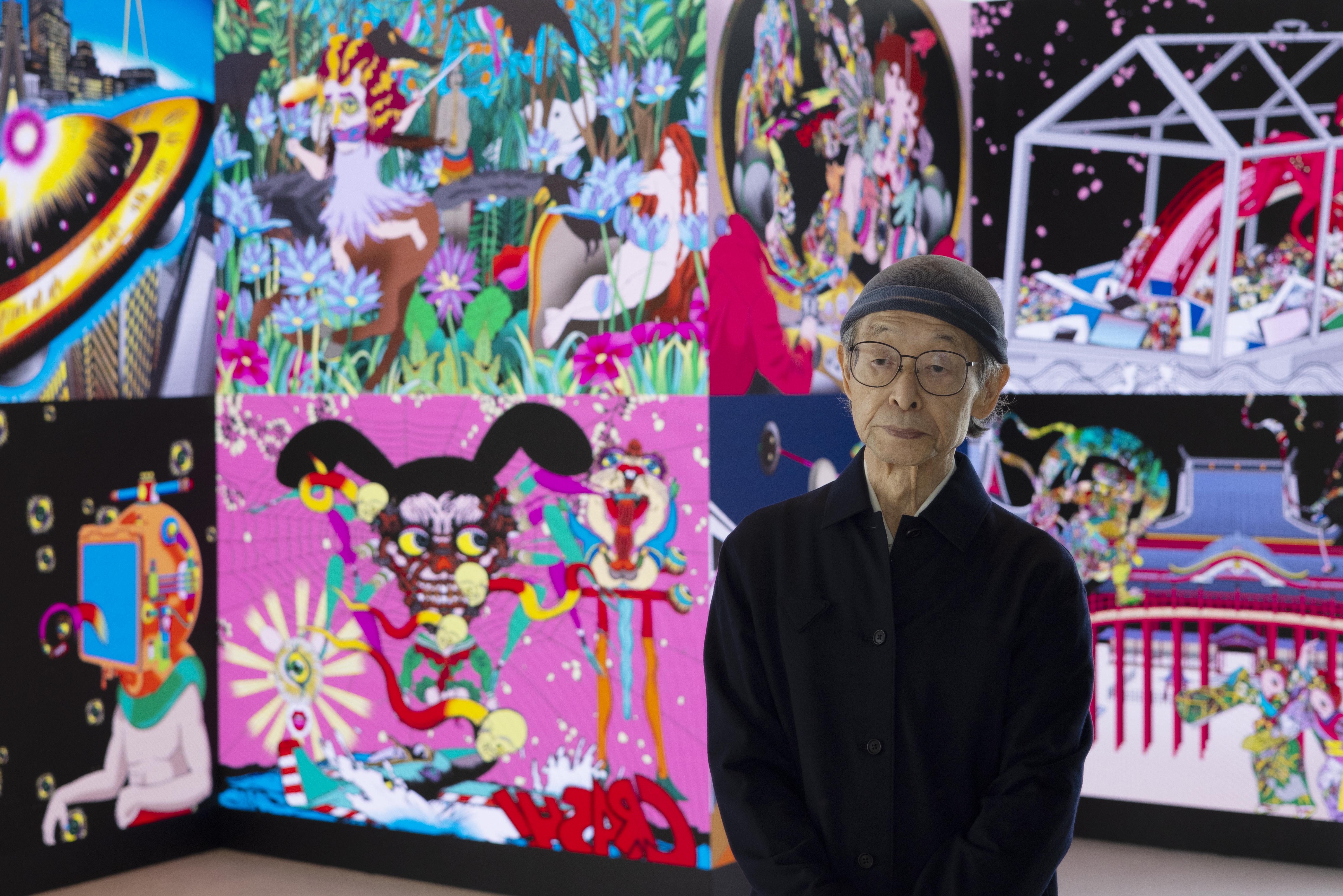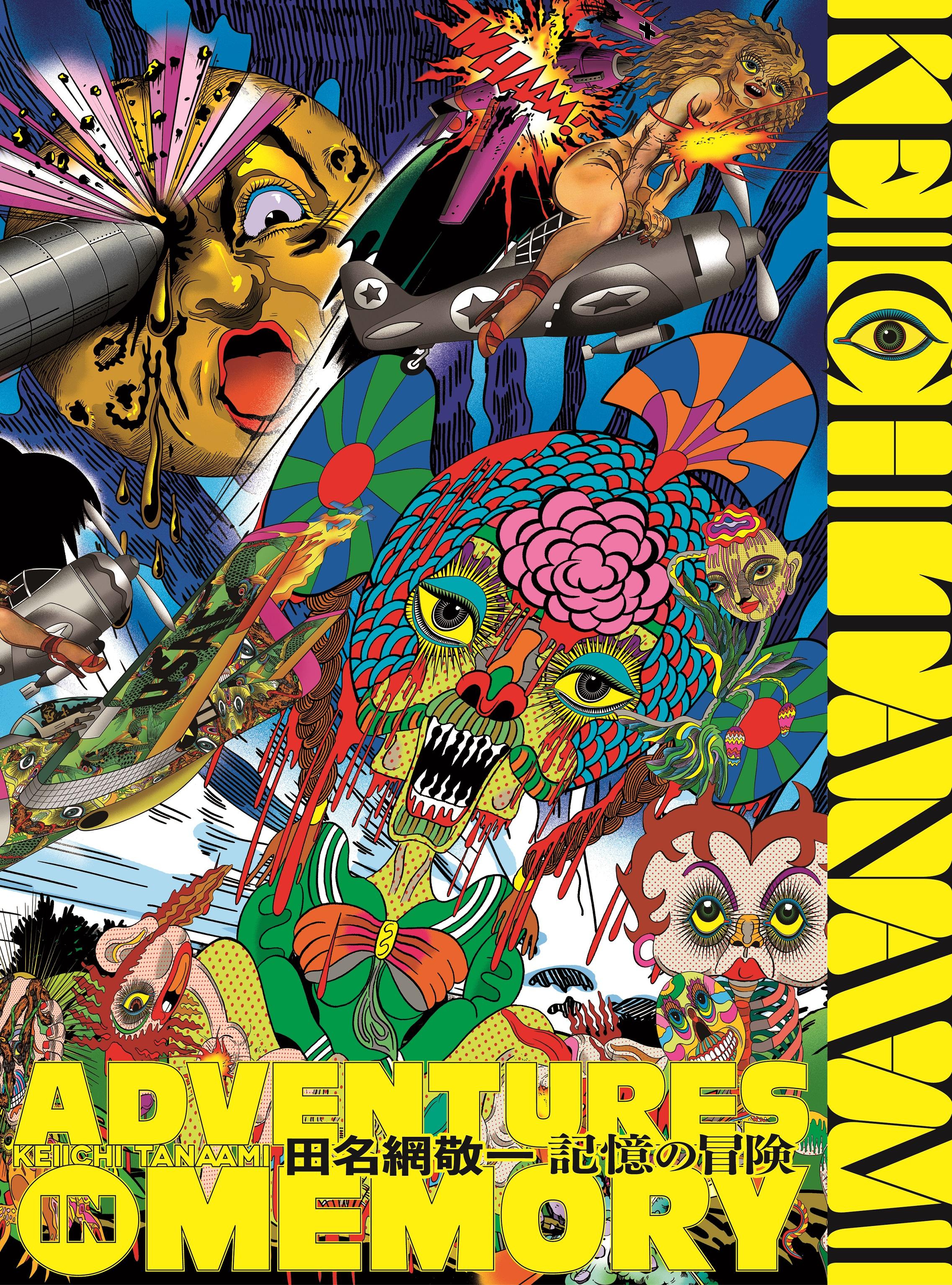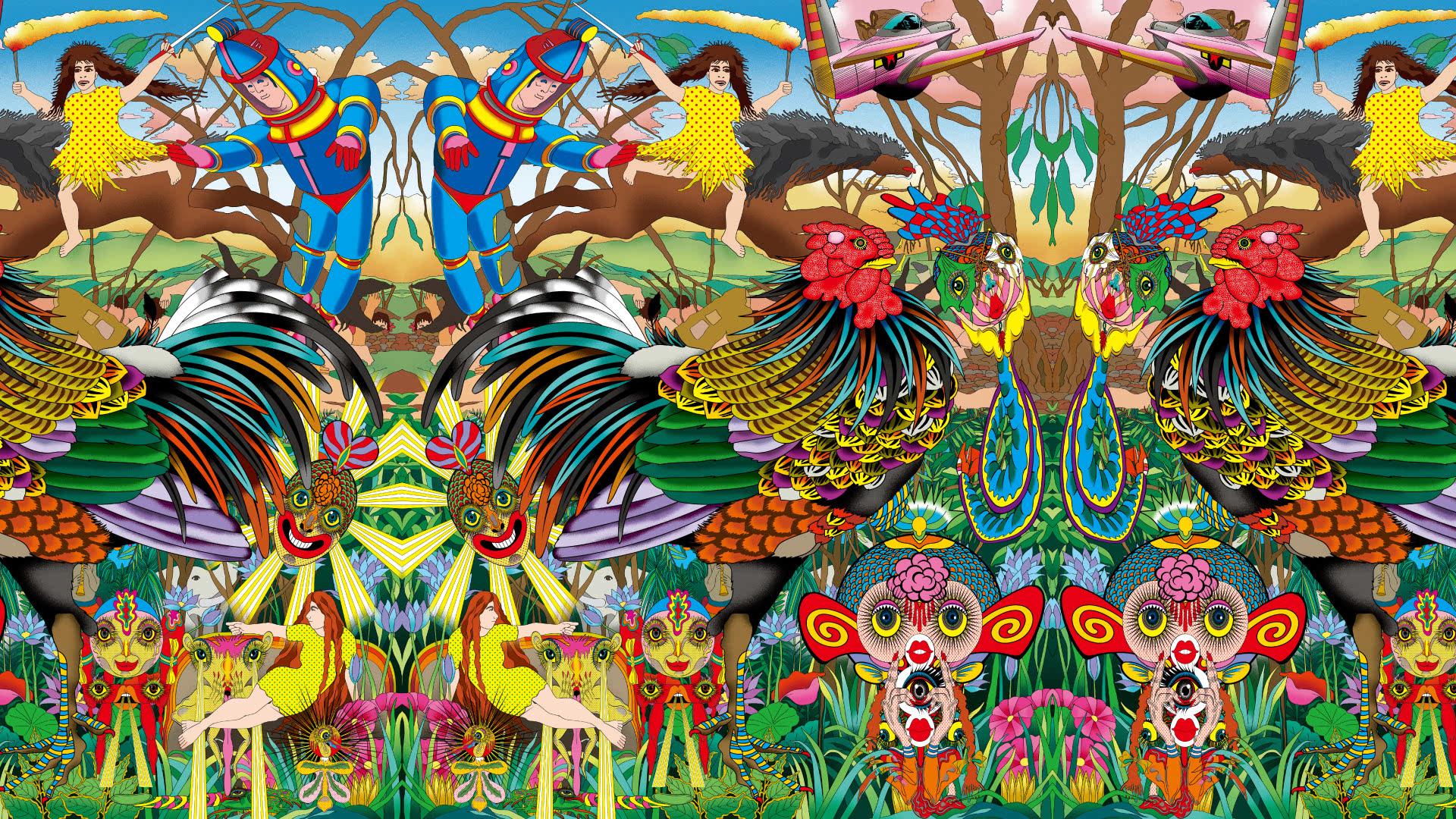Keiichi Tanaami: Adventures in Memory
August 7 (Wed), 2024 - November 11 (Mon), 2024
- Past Exhibitions
- Special Exhibitions
Keiichi Tanaami: A Genre-Busting Contemporary Pioneer
The Japanese artist Keiichi Tanaami has recently been enjoying a surge in positive critical reappraisal. He began his career as a designer while enrolled at Musashino Art University, and in 1975 he became the first art director of the monthly magazine PLAYBOY (Japanese edition). Tanaami became a leading figure in Japan’s underground art scene primarily on the strength of his work in magazines and advertisements. From the 1960s until today, he has prolifically produced paintings, collages, sculptures, animations, experimental video pieces, and installations, applying methodologies and techniques he developed in the design field. Defying confinement to specific genres or conventional rules, he has had a significant impact in an art-historical context. This exhibition is the first major retrospective covering Tanaami’s creative journey of more than 60 years, including the debut of his latest works, highlighting his status as a role model for contemporary artists.
Overview
- Period
-
August 7 (Wed), 2024 – November 11 (Mon), 2024
Closed on Tuesdays
- Opening Hours
10:00-18:00
(Fridays and Saturdays, 10:00-20:00)
(Last admission 30 minutes before closing)- Venue
-
The National Art Center, Tokyo
Special Exhibition Gallery 1E
7-22-2 Roppongi, Minato-ku, Tokyo 106-8558 - Inquiries
(+81) 47-316-2772 (Hello Dial)
Admissions & Tix
| General | 2,000 yen (Adults) 1,400 yen (College students) 1,000 yen (High school students) |
|---|---|
| ONLINE TICKET |
|
* All prices include tax.
- Tickets are available at
・The National Art Center, Tokyo (on sale from August 7, open days only)
・ONLINE TICKET "e-tix" (on sale from 10:00, July 19) - Visitors who are junior high school students or younger will be admitted for free.
- Disabled persons (along with the one assistant) will be admitted for free upon presenting the Disabled Person’s Booklet or an equivalent form of government-issued ID.
- Free entrance to the exhibition for high school students from August 19 (Mon) to August 25 (Sun), 2024, upon presenting student ID. *Closed on August 20 (Tue.)
- Reduction (100 yen off) applies to visitors who present the ticket stub of a current exhibition at The National Art Center, Tokyo; Suntory Museum of Art; or Mori Art Museum (Art Triangle Roppongi). Please show the ticket stub at the "Keiichi Tanaami: Adventures in Memory" exhibition ticket booth.
- Students, faculty and staff, of “Campus Members”, can view this exhibition for 1,200 yen (students) and 1,800 yen (faculty/staff). Please purchase tickets at the "Keiichi Tanaami: Adventures in Memory" exhibition ticket booth.
-
Credit card (Master Card, VISA, JCB, AMEX, Diners Club, DISCOVER, 銀聯, QUICPay), e-cash (Suica, PASMO, ICOCA, etc.), iD, Union Pay are available for purchasing tickets.
About the Artist
Keiichi Tanaami
Born in Tokyo in 1936, and graduated from Musashino Art University. Keiichi Tanaami has achieved unparalleled recognition for his interdisciplinary activities, as an art director, experimental filmmaker, animator and artist.
Tanaami’s recent solo exhibitions include PARAVENTI: KEIICHI TANAAMI (Prada Aoyama, Tokyo, Japan, 2023), Manhattan Universe (Venus Over Manhattan, New York, USA, 2022), A Mirror of the World (NANZUKA UNDERGROUND, Tokyo, Japan, 2022), Keiichi Tanaami (Kunstmuseum Luzern, Switzerland, 2019), Keiichi Tanaami (Jeffrey Deitch, New York, 2019). He is internationally acclaimed as a pioneer of Pop Art in Japan, with work featured in retrospective surveys with a global scope such as International Pop (Walker Art Center, Dallas Museum of Art, Philadelphia Museum of Art, USA, 2015-2016) and The World Goes Pop (Tate Modern, London, UK, 2015). Tanaami’s works are housed in numerous public collections including The Museum of Modern Art (USA), Walker Art Center (USA), The Art Institute of Chicago (USA), M+ (Hong Kong), National Portrait Gallery (USA), and Hamburger Bahnhof (Germany).
|
|
Exhibition Outline
This exhibition is the first major retrospective showcasing the internationally acclaimed artist Keiichi Tanaami (b. 1936). Tanaami is known for vivid, color-drenched works that intensely reflect his childhood memories of World War II and the impact of the American pop culture he encountered after the war. The exhibition presents an array of works by the astoundingly productive artist, including archival materials from past decades, tracing the entirety of Tanaami’s creative journey over more than 60 years. This unprecedented, comprehensive exploration of Tanaami’s oeuvre is organized around the theme of “memory.”
|
Keiichi Tanaami, Realm of the Afterlife / Realm of the Living, 2017. |
After enrolling in the college of design at Musashino Art University, Tanaami befriended avant-garde artists such as Ushio Shinohara, Genpei Akasegawa, and Shusaku Arakawa, and was exposed to their cutting-edge activities. In 1957, while still a student, he won a special selection award at the Japan Advertising Art Exhibition, held by the Japan Advertising Artists Club. He began taking on design jobs while still enrolled in school, and joined the Hakuhodo ad agency after graduating. After about two years he left Hakuhodo and became independent, not only holding gallery exhibitions but also publishing a collection of works in 1966 titled A Portrait of Keiichi Tanaami, which can be described as the starting point of his career as an artist. Profoundly inspired by Andy Warhol’s approach to art and design, which refused to be limited to any one medium, he came to describe himself as an “image director.” Tanaami went on to prolifically produce silkscreened posters [1], collages, animations, illustrations, paintings and more [2,3].
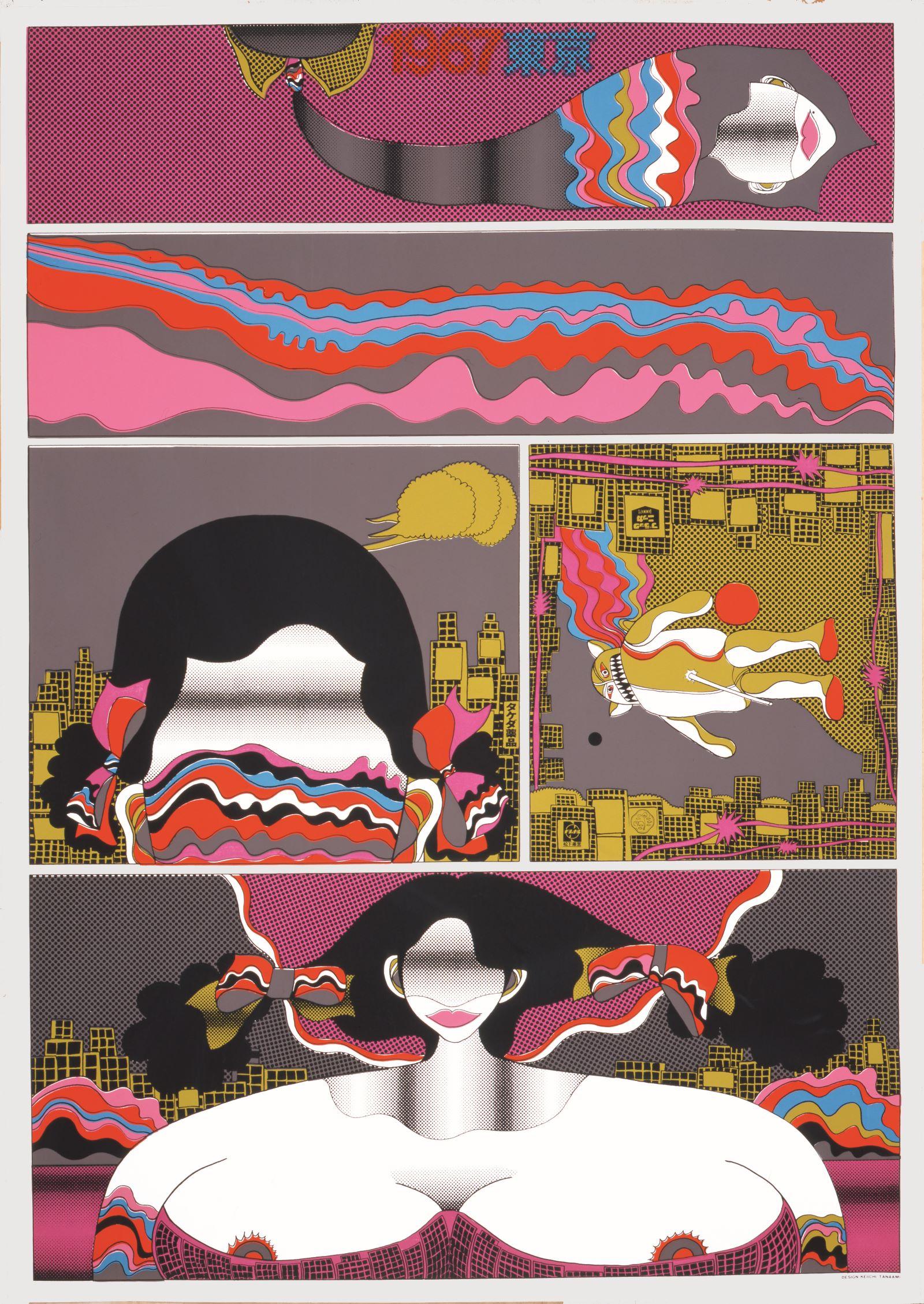
[1]Keiichi Tanaami, 1967 TOKYO, 1967
Silkscreen print on paper
103×72.8 cm
©Keiichi Tanaami / Courtesy of NANZUKA
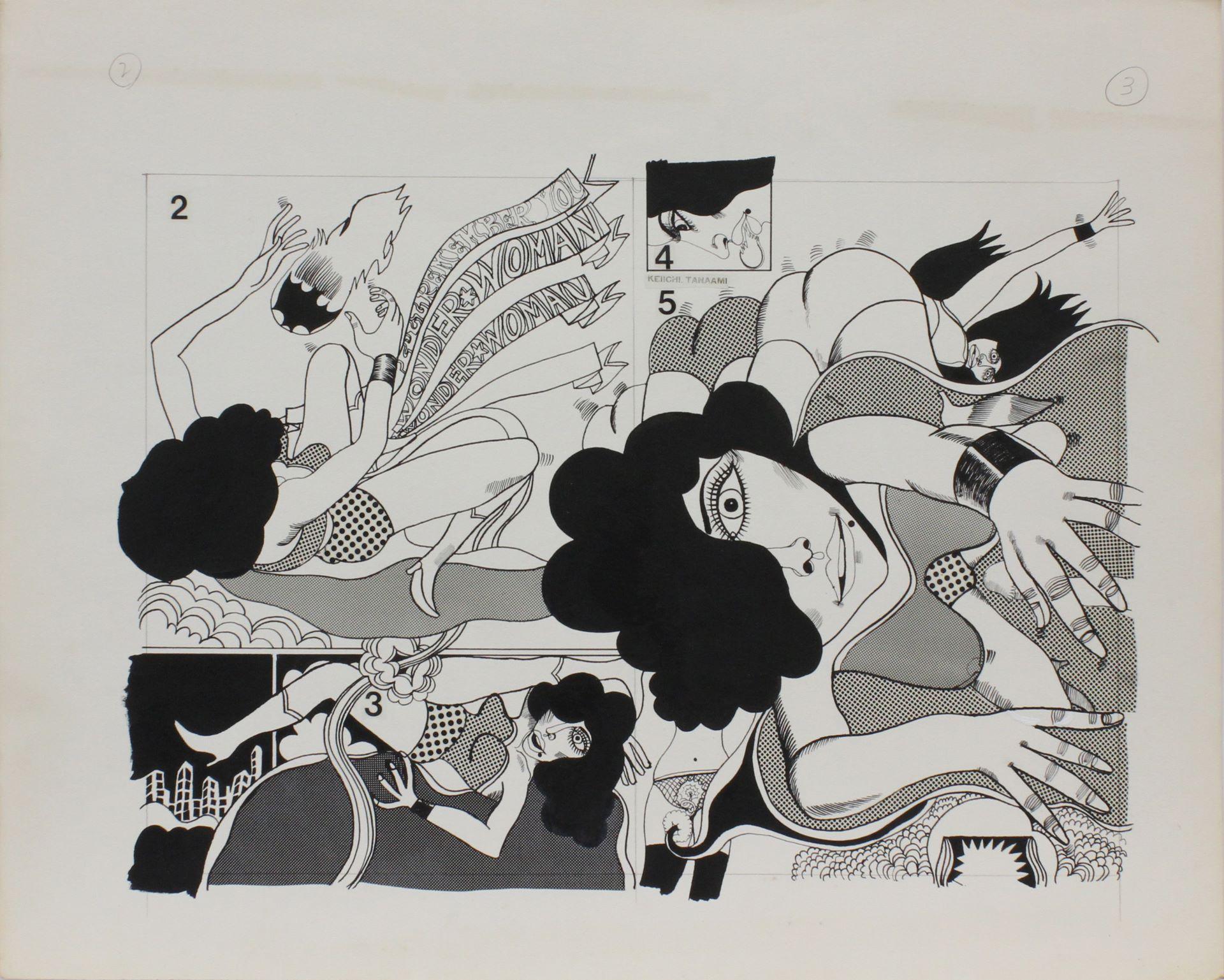
[2]Keiichi Tanaami, Wonder Woman, 1967
Ink, collage on paper
38.5×48.5 cm
©Keiichi Tanaami / Courtesy of NANZUKA
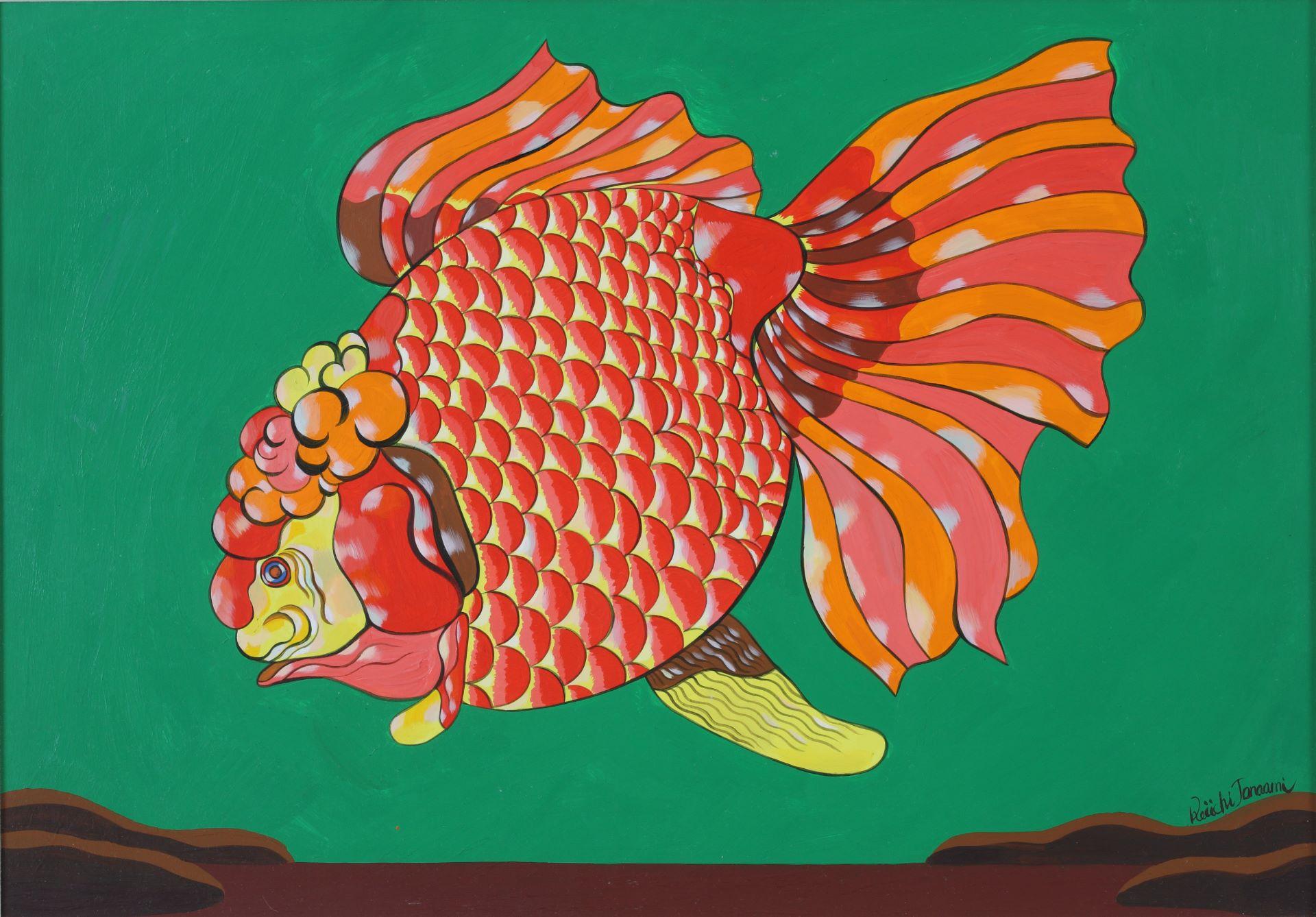
[3]Keiichi Tanaami, Gold Fish, 1975
Acrylic on illustation board
36.4×51.5 cm
©Keiichi Tanaami / Courtesy of NANZUKA
By the late 1960s, Keiichi Tanaami was engaged in editorial design for numerous magazines covering music, movies, and literature, and in 1975 he became the first art director of the monthly magazine PLAYBOY (Japanese edition). Around the same time, he also began producing experimental films and holding screenings with filmmaker Toshio Matsumoto, steadily expanding the scope of his creative endeavors.
A trip to China, and hallucinations he experienced during a four-month hospitalization in 1981, inspired him to produce images reminiscent of Oriental paradises and fantastical labyrinths in the 1980s [4,5,6]. In 1991 Tanaami became a professor at Kyoto University of Art and Design, where he has helped to foster artists of younger generations.
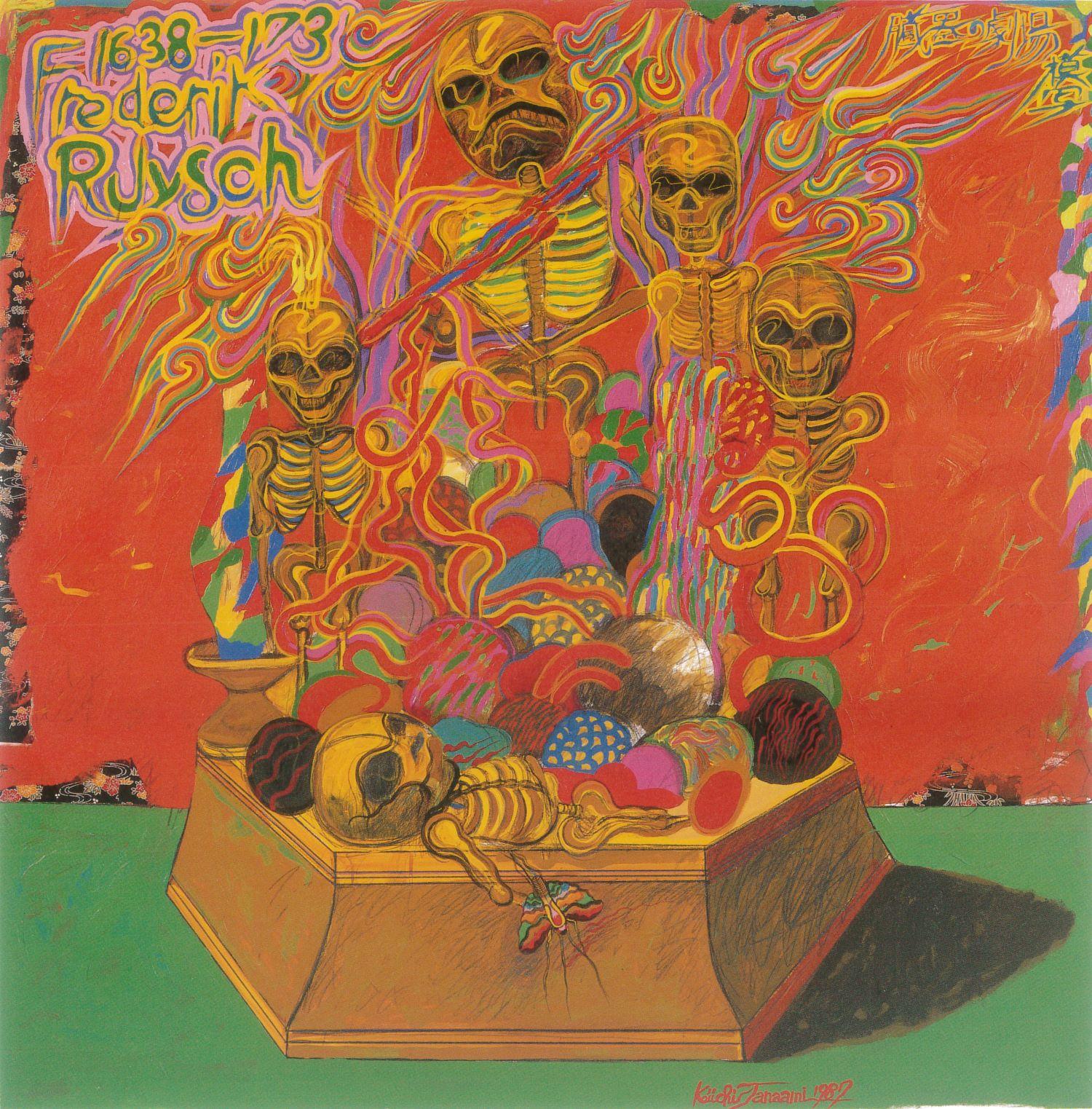
[4]Keiichi Tanaami, Frederik Ruych - Theater of Internal Organs, 1987
Acrylic on canvas
145.5×145.5×3.6 cm
©Keiichi Tanaami / Courtesy of NANZUKA
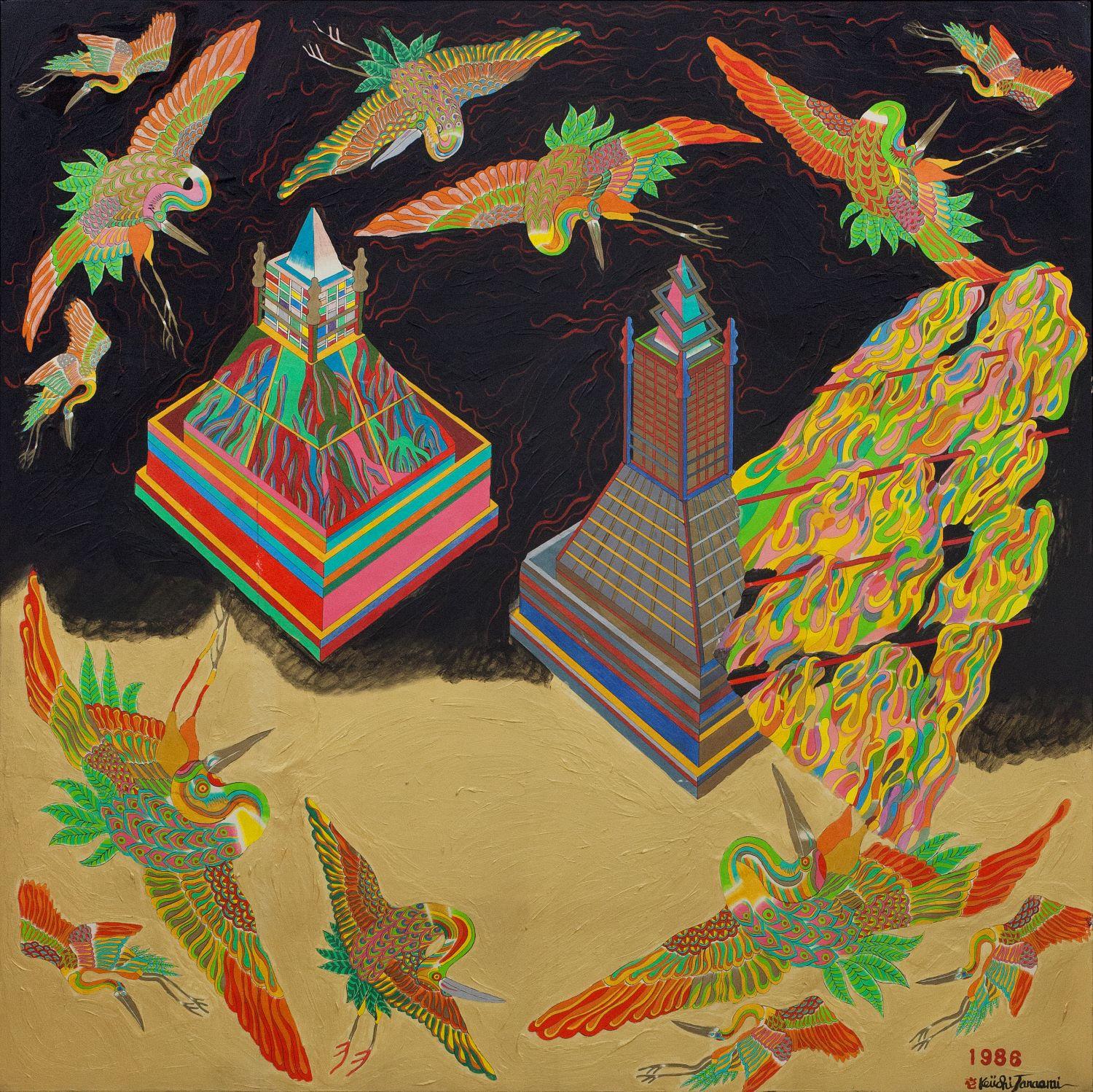
[5]Keiichi Tanaami, Passage, 1986
Acrylic and color pencil on paper mounted on canvas
130.5×130.5 cm
©Keiichi Tanaami / Courtesy of NANZUKA
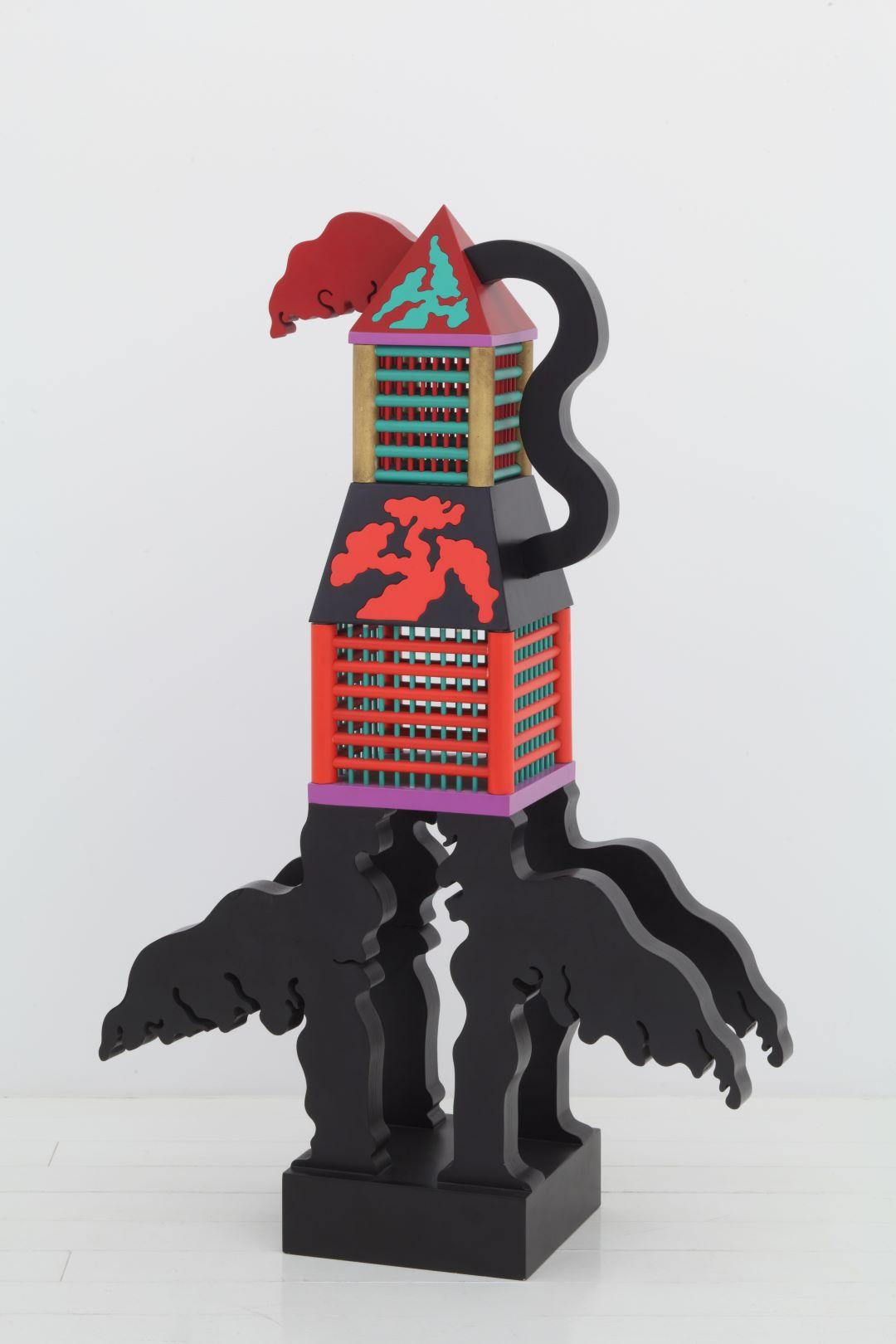
[6]Keiichi Tanaami, The House in Ascension, 1987
Wood and lacquer
100×63.5×24 cm
©Keiichi Tanaami / Courtesy of NANZUKA
Around 2000, Tanaami began combining various motifs appearing in his earlier works to create even more complex and dynamic images [7,8]. For Tanaami, creating art is a process of tracing past memories and seeking to interpret how these memories have evolved within him at a subconscious level.
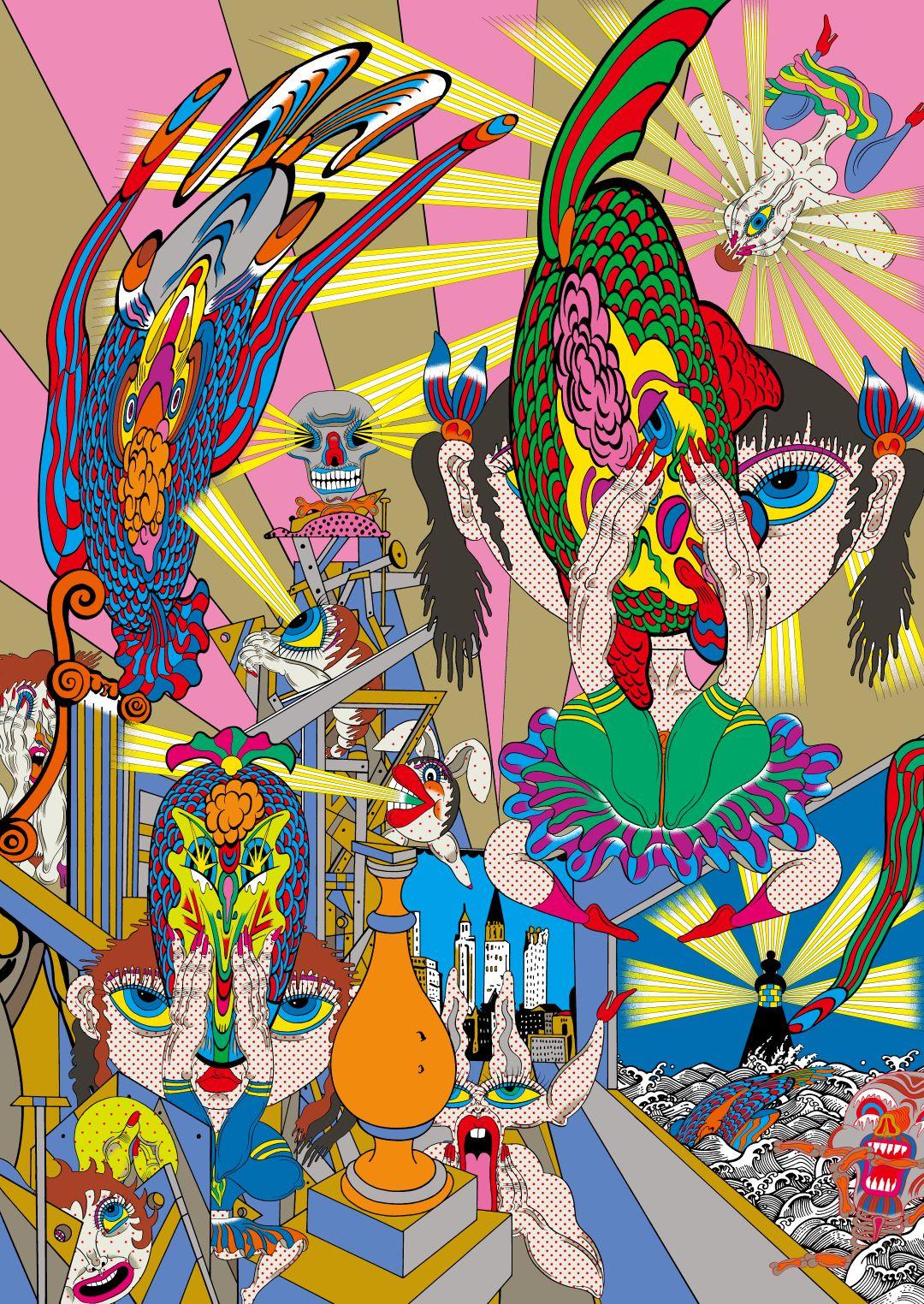
[7]Keiichi Tanaami, Chirico's Theater, 2009
Acrylic on canvas
195×145.5 cm
©Keiichi Tanaami / Courtesy of NANZUKA
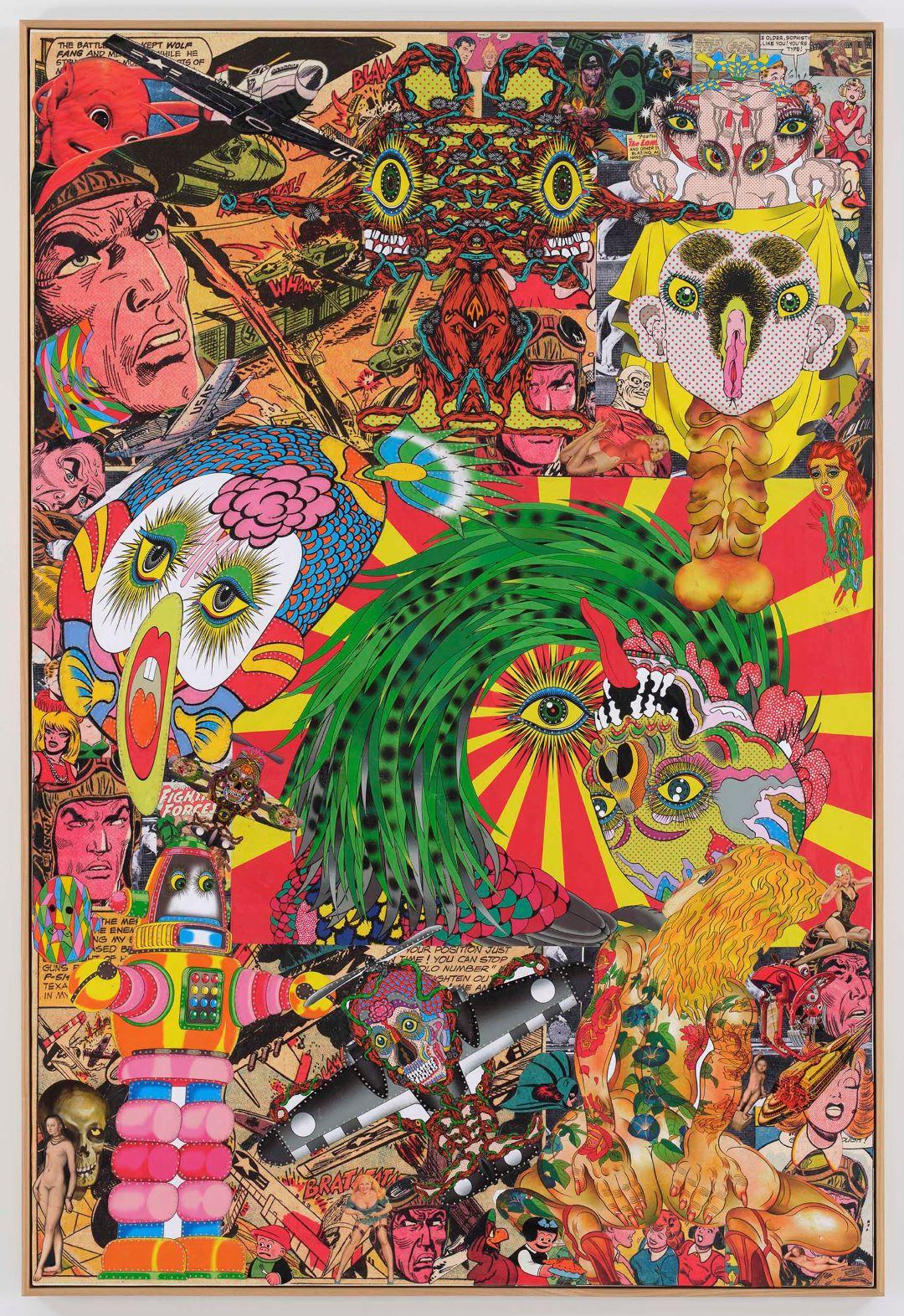
[8]Keiichi Tanaami, Presence, 2022
Digital canvas print, magazine scrap, ink, acrylic paint, and rhinestone on canvas
194×130×4 cm
©Keiichi Tanaami / Courtesy of NANZUKA
At the age of 88, Keiichi Tanaami continues to create with undimmed energy, enthralling artists and designers of many generations and nationalities and receiving a deluge of requests for collaborations. This can be attributed to his inimitable sensibilities and continuous renewal of his style and methodologies over more than six decades of activity. Recently, Tanaami has gained growing international recognition as a postwar Japanese artist who interprets global culture in a truly distinctive manner, and his works are in the collections of such institutions such as The Museum of Modern Art, New York (MoMA) (USA), the Walker Art Center (USA), the Art Institute of Chicago (USA), M+ (Hong Kong), and the Hamburger Bahnhof – Nationalgalerie für Gegenwart (Germany).
This exhibition offers a long-awaited opportunity for viewers to immerse themselves in the world of Tanaami’s works, which resemble mind-bending collages of memory and imagination, boldly synthesizing truth and fiction and continuing to surge in popularity and critical appraisal.
Exhibited Highlights
Works Intimately Intertwined with Japan’s Postwar Cultural History
The works on view include ORDER MADE!! Series (1965) [9,10], which drew inspiration from Andy Warhol and was one of the first examples of Japanese Pop Art; NO MORE WAR Series(1967), a finalist in an anti-Vietnam War poster contest held by the American magazine Avant Garde; and the animation Good-by Marilyn (1971), created using collage techniques for the TV program 11PM. These and many other works illuminate the counterculture that blossomed in Japan after World War II.
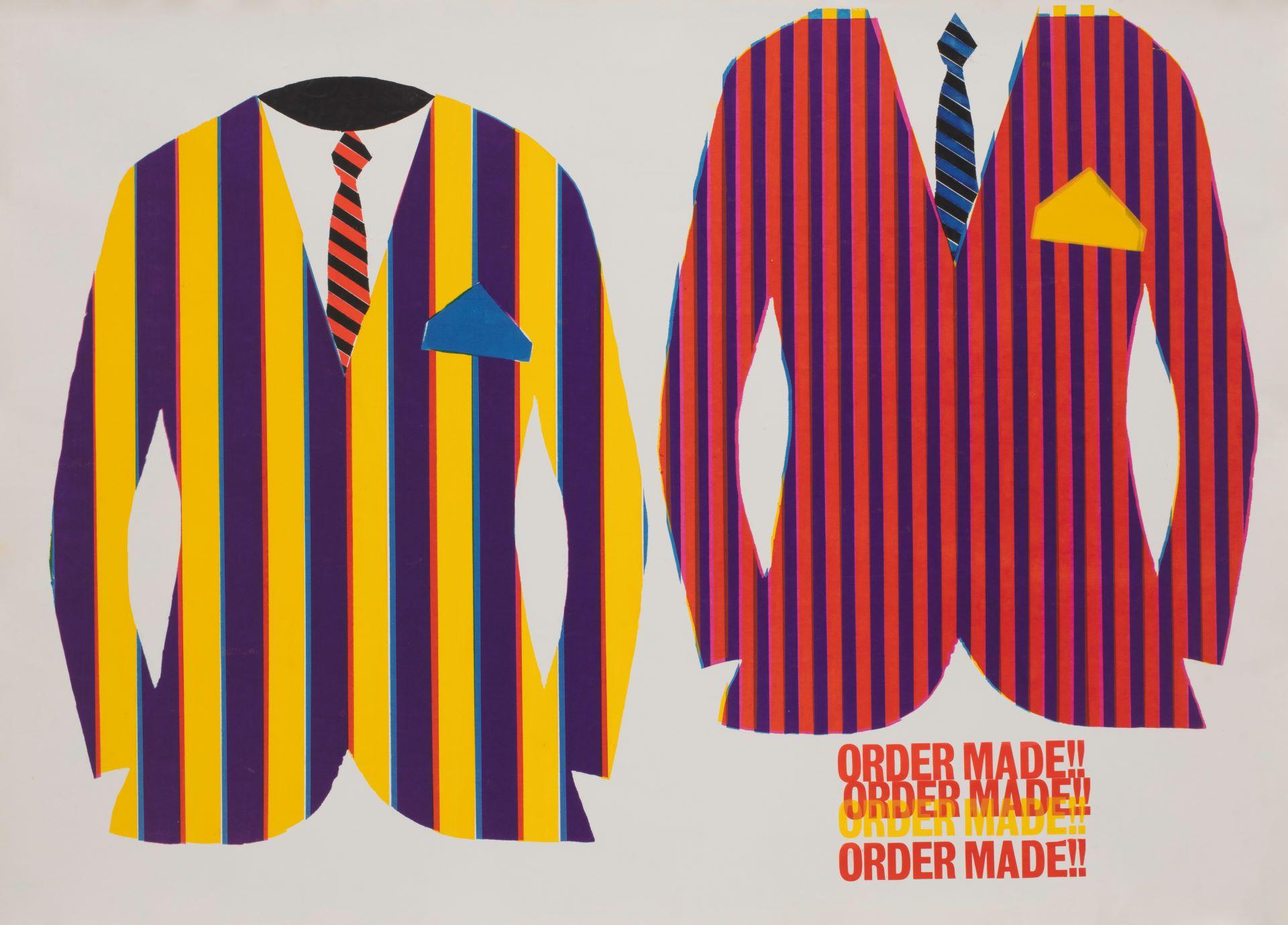
[9]Keiichi Tanaami, ORDER MADE!!, 1965
Silkscreen print on paper
78.9×109.4 cm
©Keiichi Tanaami / Courtesy of NANZUKA
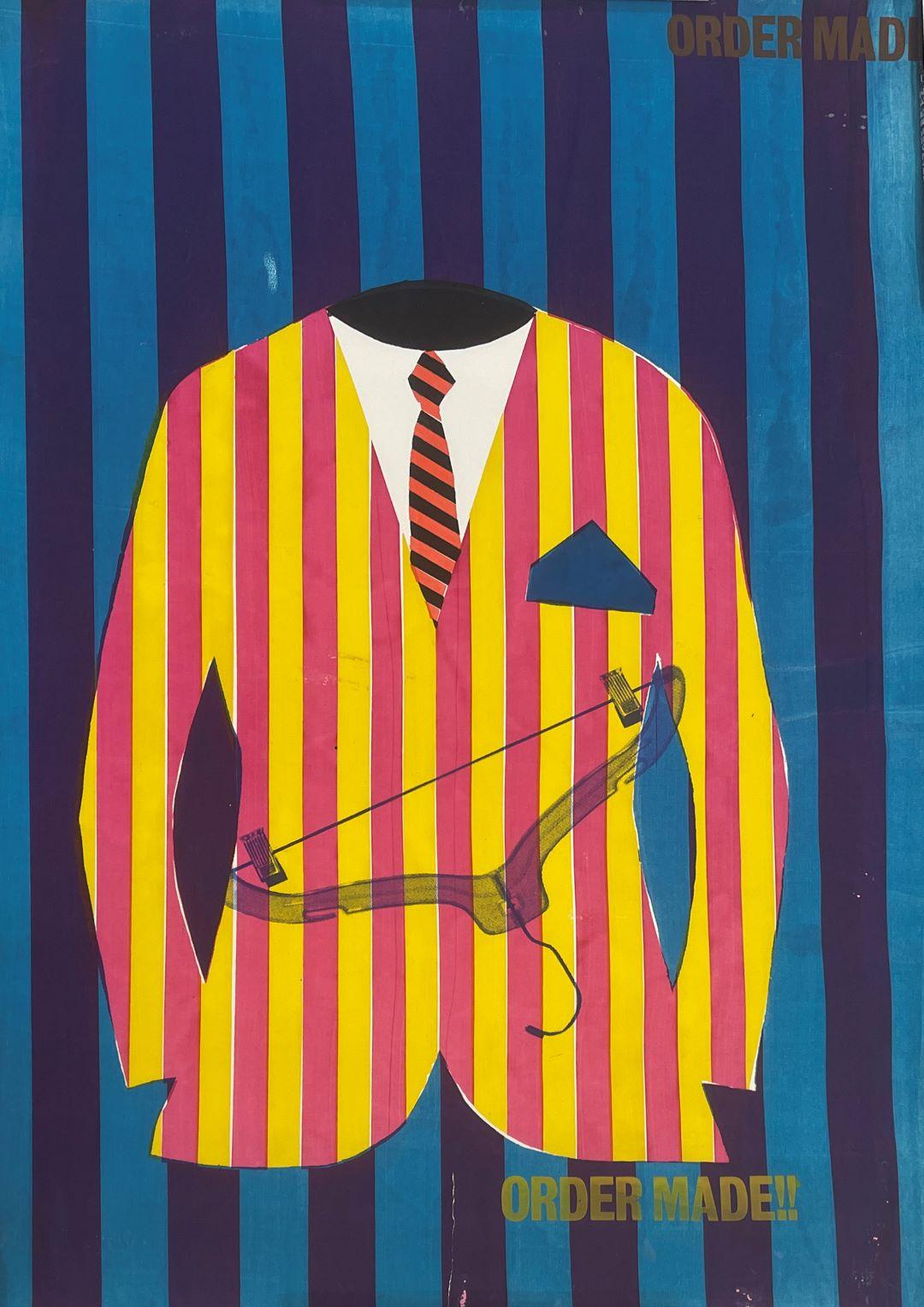
[10]Keiichi Tanaami, ORDER MADE!!, 1965
Silkscreen print on paper
101×73 cm
©Keiichi Tanaami / Courtesy of NANZUKA
An Ever-Flowing Fountain of Memories
In recent years, Tanaami has produced numerous works with themes drawn from his own memories and dreams. Childhood experiences in wartime, and a severe and life-threatening illness, have been significant catalysts for his focus on memories magnified in the mind, reflecting the idea that “people unconsciously alter their own memories as they go through life.” Titled Adventures in Memory, the exhibition features new works [11] exhibited for the first time, as well as dream diaries which Tanaami has kept sporadically since the 1970s, drawings [12], and related installations [13], revealing the inexhaustible wellspring of his creativity.

[11]Keiichi Tanaami, Law of the Forest, 2024
Pigmented ink, acrylic silkscreen medium, crushed glass, glitter, and acrylic on canvas
251×200 cm
©Keiichi Tanaami / Courtesy of NANZUKA
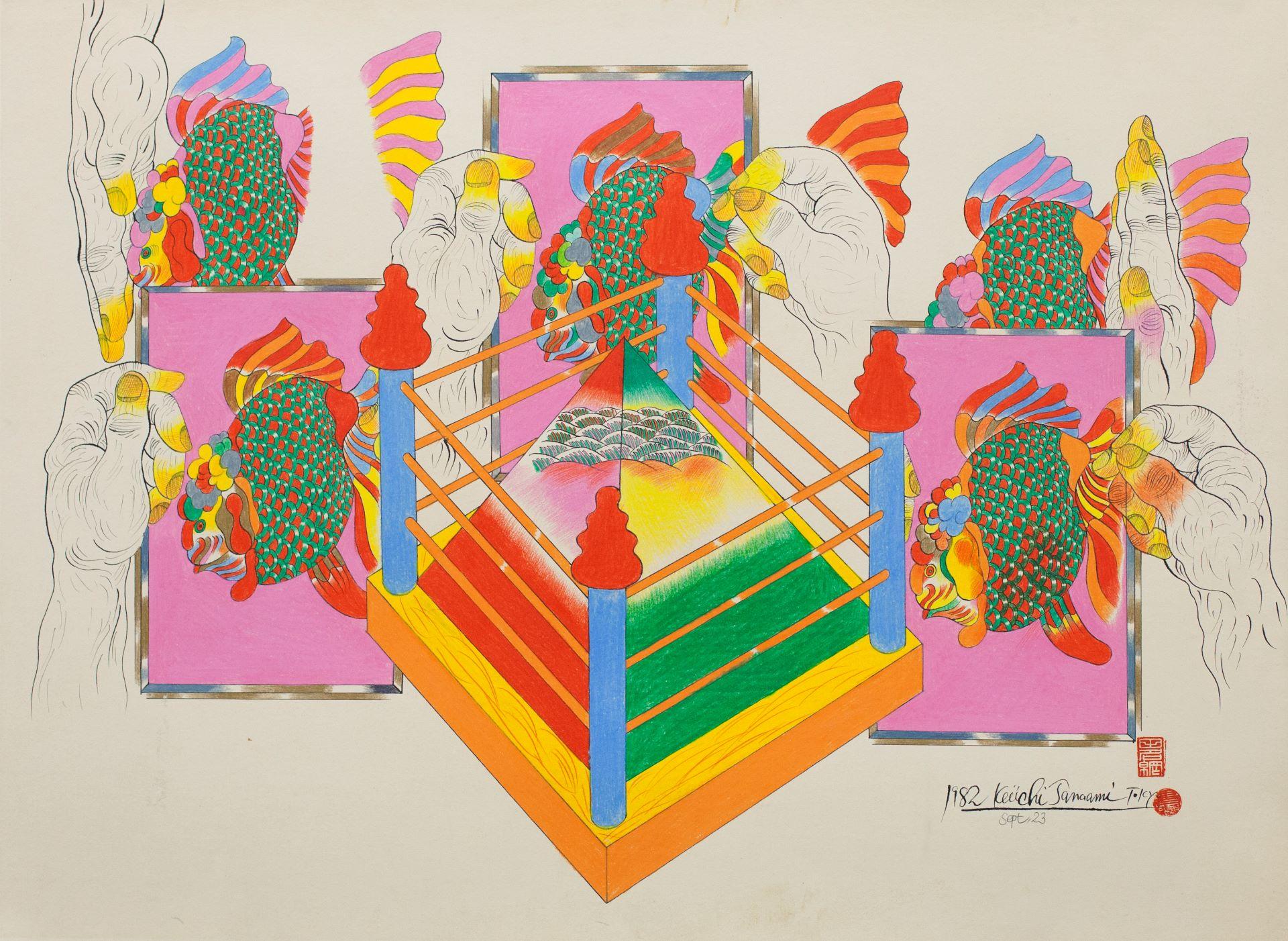
[12]Keiichi Tanaami, Goldfish, 1982
Acrylic, ink, and color pencil on paper
56.5×76.5 cm
©Keiichi Tanaami / Courtesy of NANZUKA
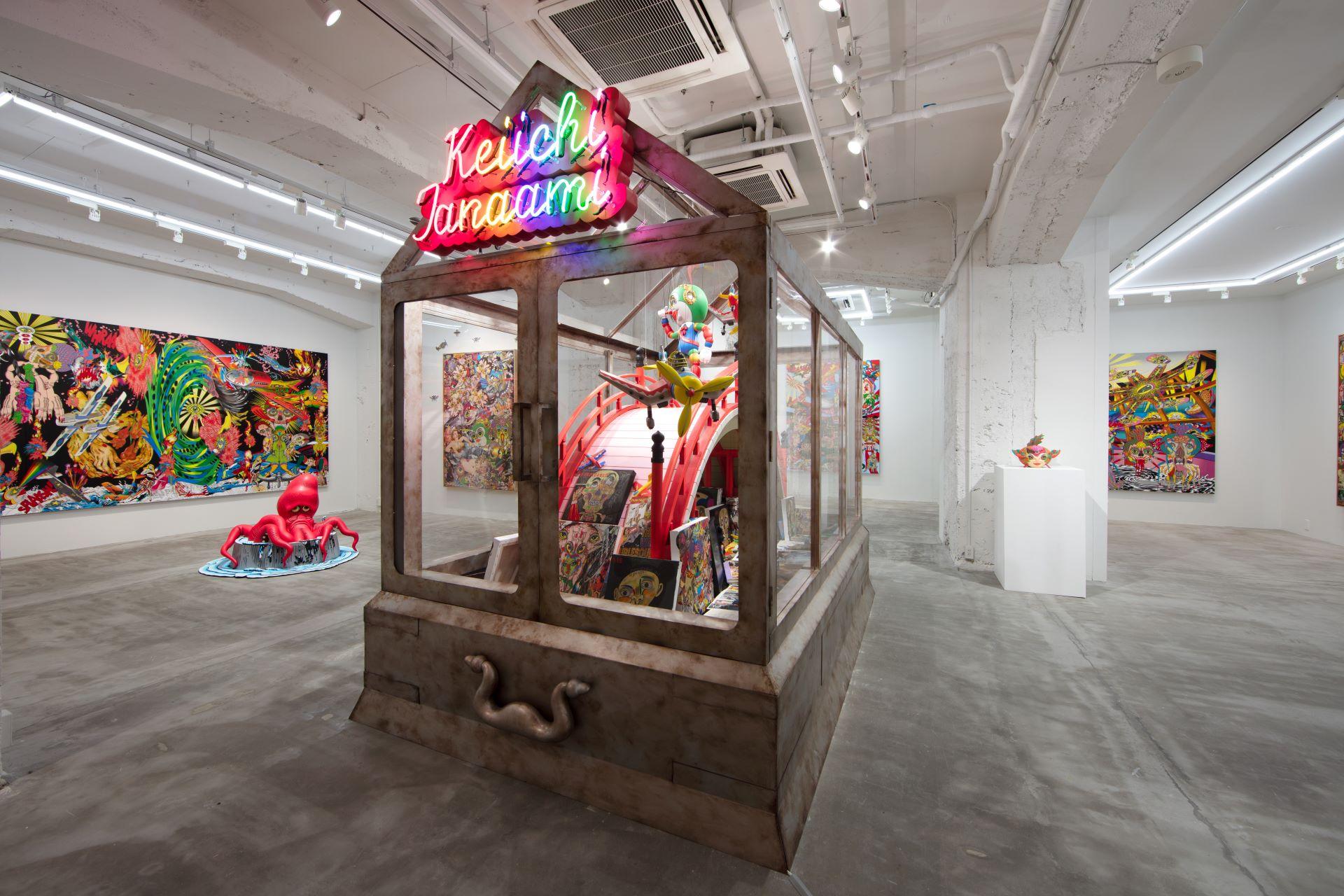
[13]Keiichi Tanaami, Memory Reconstruction, installation view of the exhibition “Keiichi Tanaami: Memory Reconstruction,” NANZUKA, Tokyo, 2020
©Keiichi Tanaami / Courtesy of NANZUKA
An Astounding Array of Collaborations
Throughout his long career, Tanaami has worked for a remarkable range of clients and with an extraordinary lineup of collaborators. These have included fashion brands, including Mary Quant, adidas [14], JUNYA WATANABE, and Ground Y, and musicians, such as GENERATIONS from EXILE TRIBE, Aki Yashiro, and RADWIMPS [15]. He has also worked with iconic characters like Ultraman and joined forces with the late manga artist Fujio Akatsuka [16], with whom he had a friendship. The exhibition highlights Tanaami’s achievements as a designer, showing his deep commitment to collaboration since the earliest days of his career, as well as his approach to producing new works through synergies generated by partnerships.
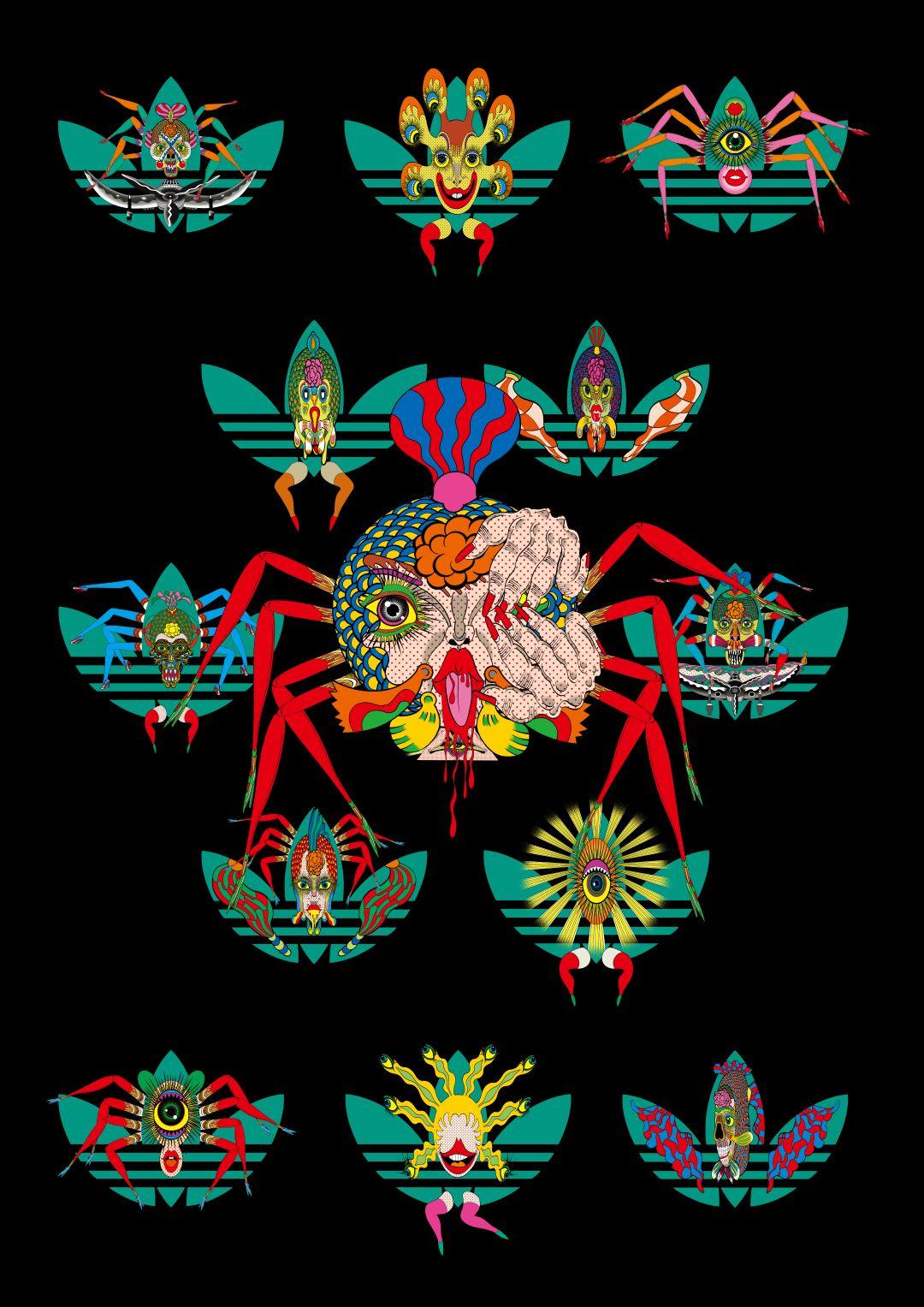
[14]Keiichi Tanaami, The Kingdom of Dream, 2018
Pigmented ink, acrylic silkscreen medium, crushed glass, glitter, and acrylic on canvas
140×100×4 cm
©Keiichi Tanaami / Courtesy of NANZUKA
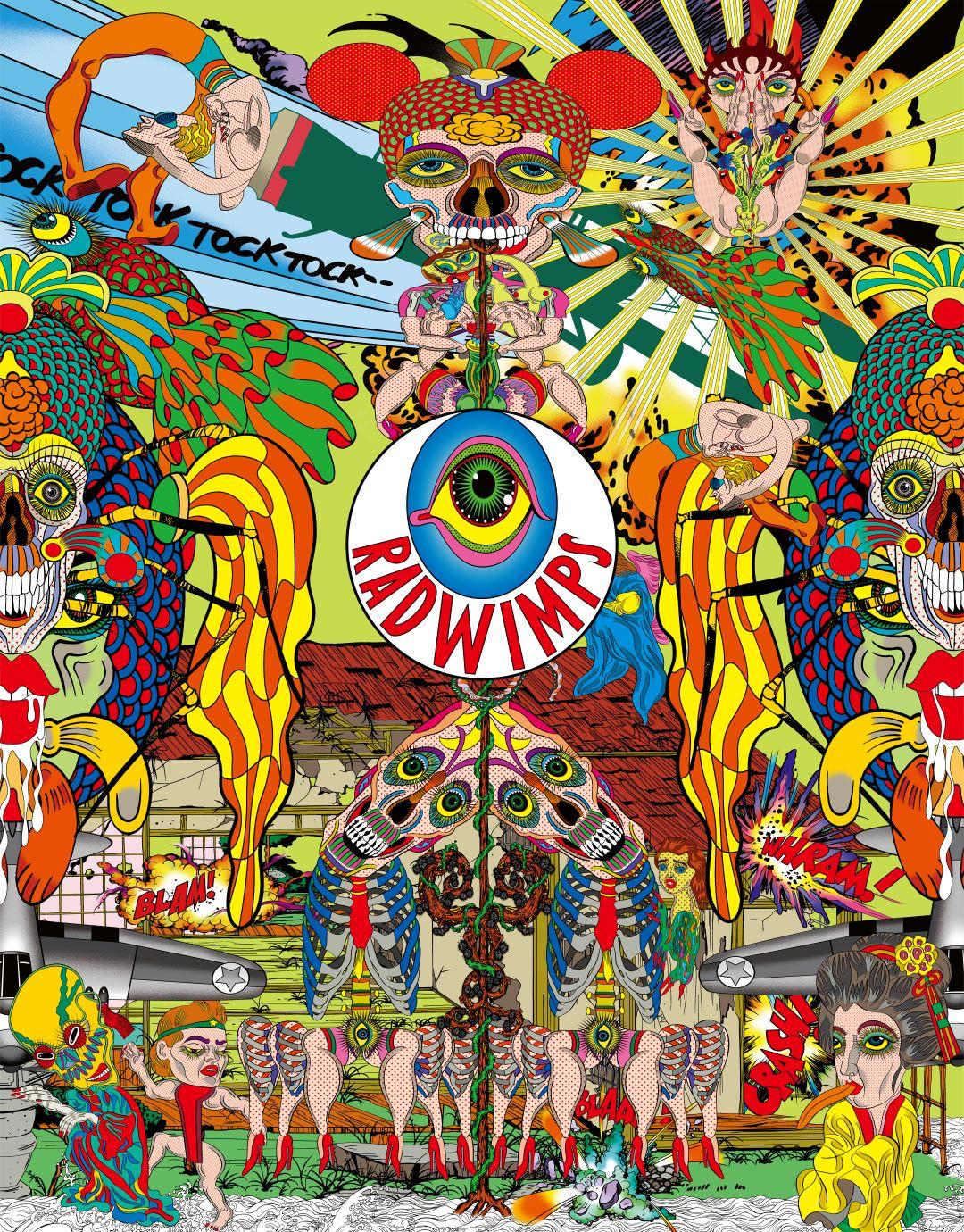
[15]Keiichi Tanaami, Artwork for RADWIMPS WORLD TOUR 2024 “The way you yawn, and the outcry of Peace” , 2024
Silkscreen print and glitter on paper
51.7×41.7 cm
©Keiichi Tanaami / Courtesy of NANZUKA
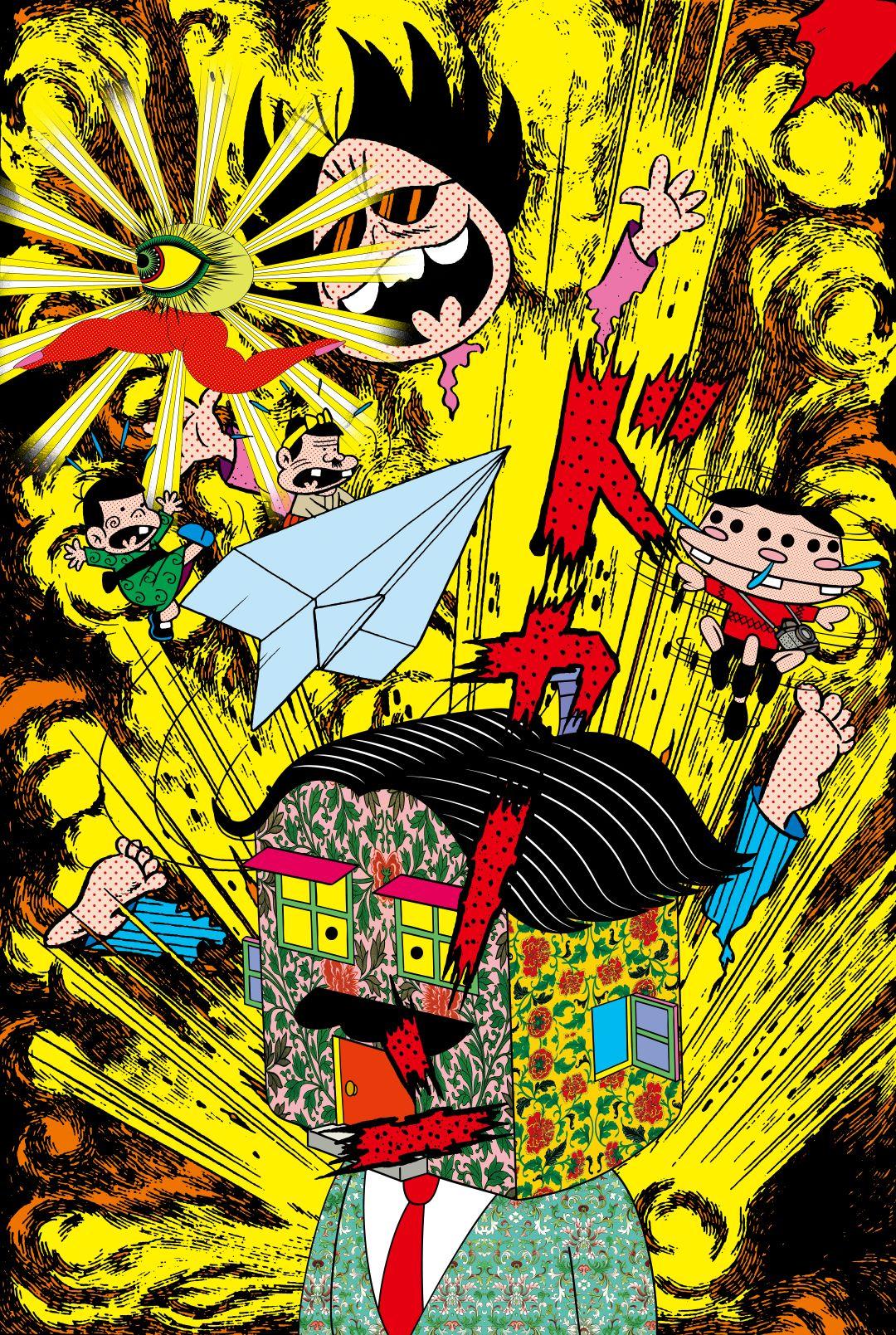
[16]Keiichi Tanaami, Kaboom, 2022
Pigmented ink, acrylic silkscreen medium, crushed glass, glitter, and acrylic on canvas
149×100 cm
©Keiichi Tanaami / Courtesy of NANZUKA
Descriptions of Works
NO MORE WAR Series, 1967
While still a student, Tanaami began exploring various means of reaching a broader audience with his works, and became increasingly interested in techniques of reproduction such as printing and printmaking. Influenced by American comics and Pop Art, he began working with silkscreen in the mid-1960s. His works in the medium include this series, which he submitted to an anti-war poster contest organized in 1968 by the American magazine Avant Garde, where it was selected as an outstanding work. Tanaami’s halftone backgrounds, appropriations of photographs, and comic-inspired layouts not only highlight his interest in reproduction through print, but also showcase his sublime command, as a designer, of layout and color usage.
|
Keiichi Tanaami, NO MORE WAR, 1967 |
Good-by Marilyn, 1971
Since childhood, Tanaami has maintained a keen interest in film, and he began producing animated works in the mid-1960s. In the early 1970s, he was commissioned by television programs to produce several animations. One notable work features repeated images of hot dogs, bananas, and Marilyn Monroe in eroticized scenes that unfold over four and a half minutes. Images of the Statue of Liberty and Disney characters, along with cutouts from pornography, are interspersed throughout, delivering a singular interpretation of American popular culture. However, as the title hints, around this time Tanaami began gradually distancing himself from American iconography, shifting the focus of his work towards his own memories. This work can be said to represent a transitional phase of his career.
|
Keiichi Tanaami, Good-by Marilyn, 1971 |
Tokiwa-matsu Series, 1986-87
In 1981, Tanaami was diagnosed with tuberculosis and hospitalized for nearly four months. Hovering between life and death, he experienced a long series of intense nightly hallucinations due to the strong side effects of medication. These visions included recurring imagery such as the Salvador Dalí painting The Madonna of Port Lligat, and the pine trees in the hospital garden appeared to him to be twisted and contorted. Tanaami documented what he saw in more than ten notebooks, and these vivid hallucinations while hospitalized propelled him in new creative directions. A visit to China in 1980 had already reignited his interest in Asian culture, and in the 1980s he began depicting fantastical worlds, evocative of mysterious spiritual paradises and labyrinths, that combined images of pine trees and artificial urban landscapes.
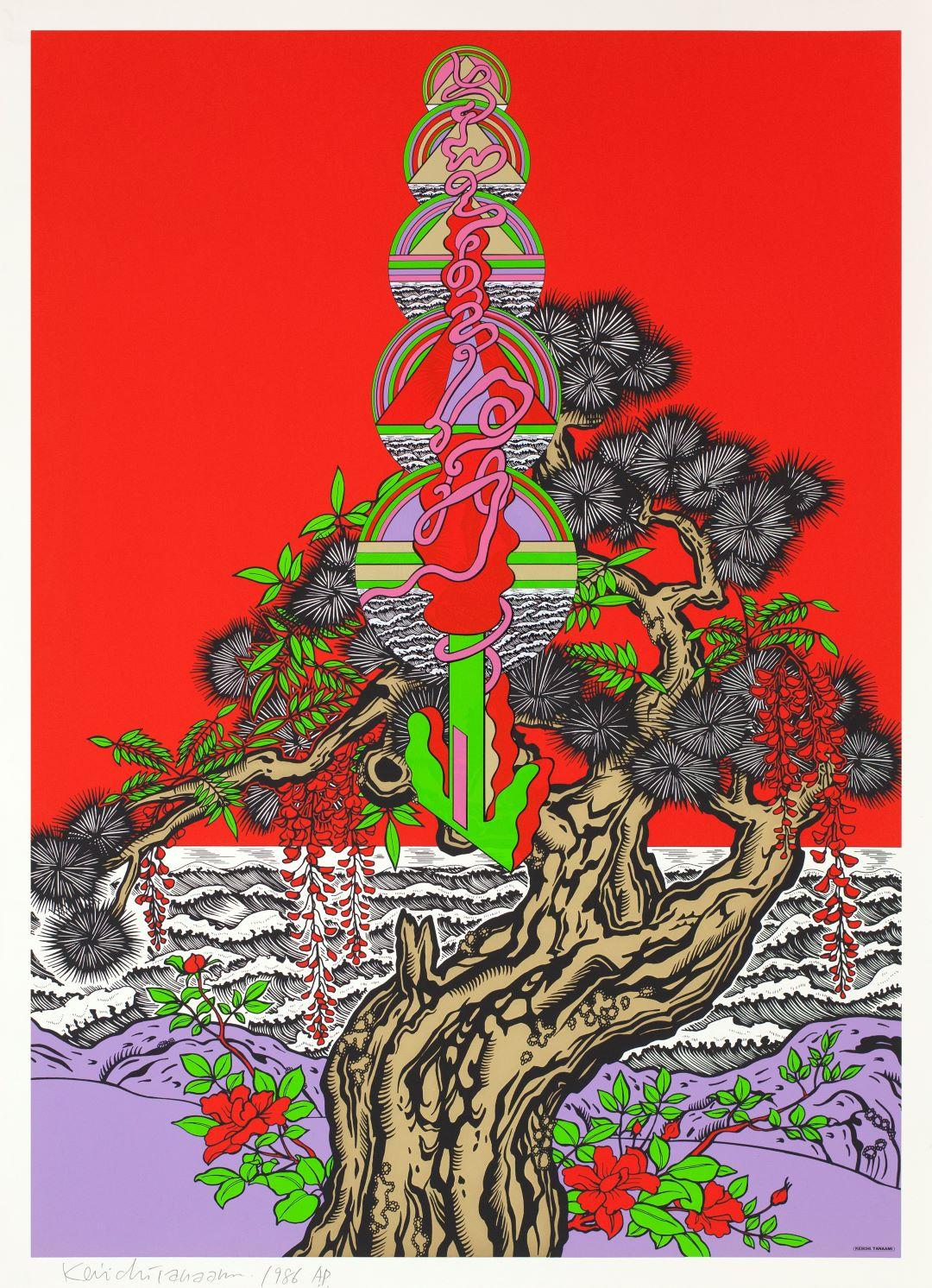
Keiichi Tanaami, Tokiwa-matsu, 1986
Silk screen print on paper
103×73 cm
©Keiichi Tanaami / Courtesy of NANZUKA
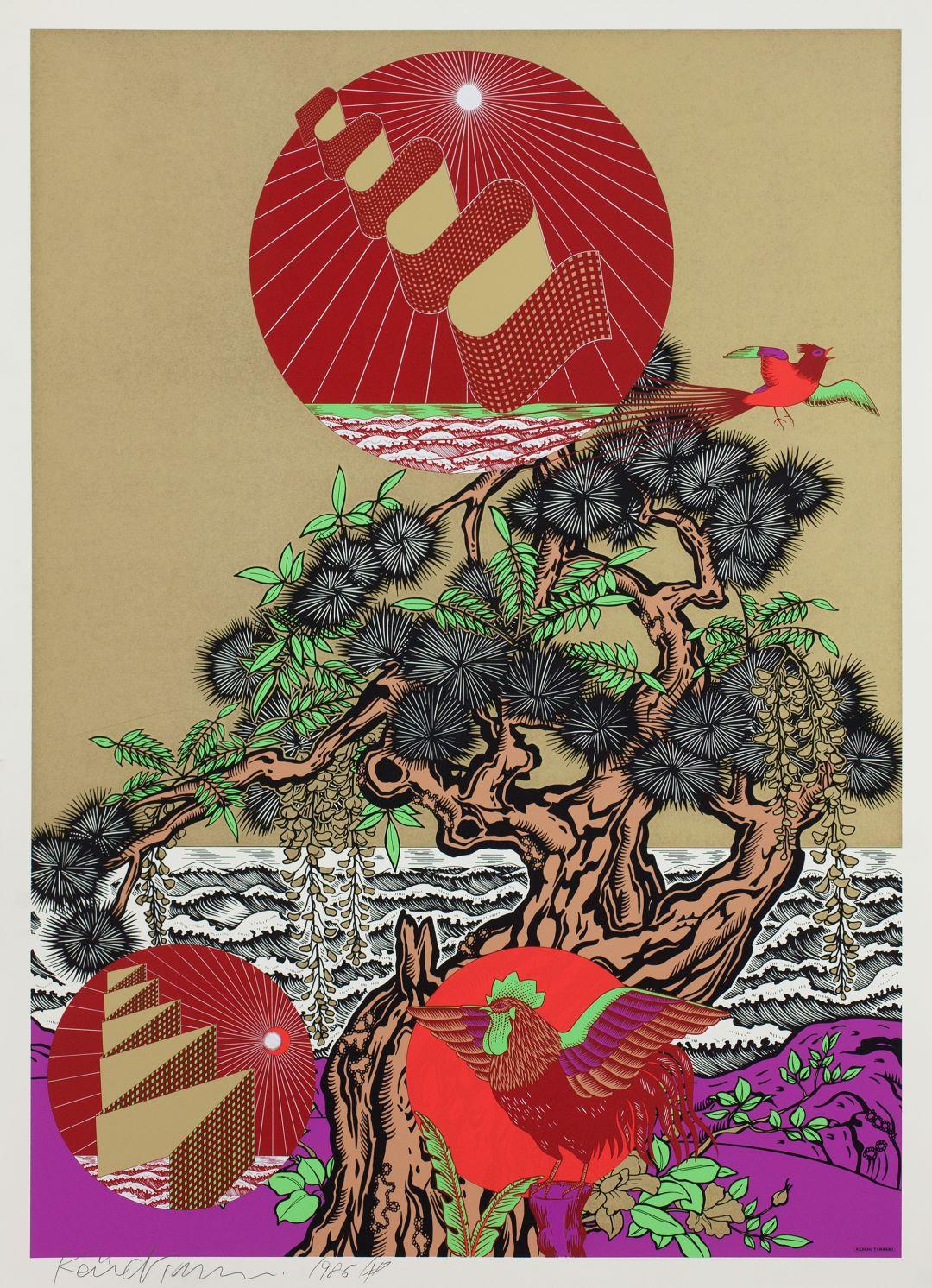
Keiichi Tanaami, Tokiwa-matsu, 1986
Silk screen print on paper
103×73 cm
©Keiichi Tanaami / Courtesy of NANZUKA
The Story of Death and Rebirth, 2019
This jaw-droppingly colorful work comprises motifs deeply linked to Tanaami’s childhood memories of wartime. For the artist, death has been a crucial theme and a continual source of creative energy. Here, numerous fighter planes sink into the sea while sprite-like creatures float in midair, presenting a vision of a chaotic world that evokes the cycle of reincarnation. In terms of technique, in the 2000s Tanaami began working with digital data, which enabled him to amplify images infinitely across various media. His ability to seamlessly introduce images into videos and sculptures further illuminates the protean nature of his talent, which has been increasingly notable in recent years.
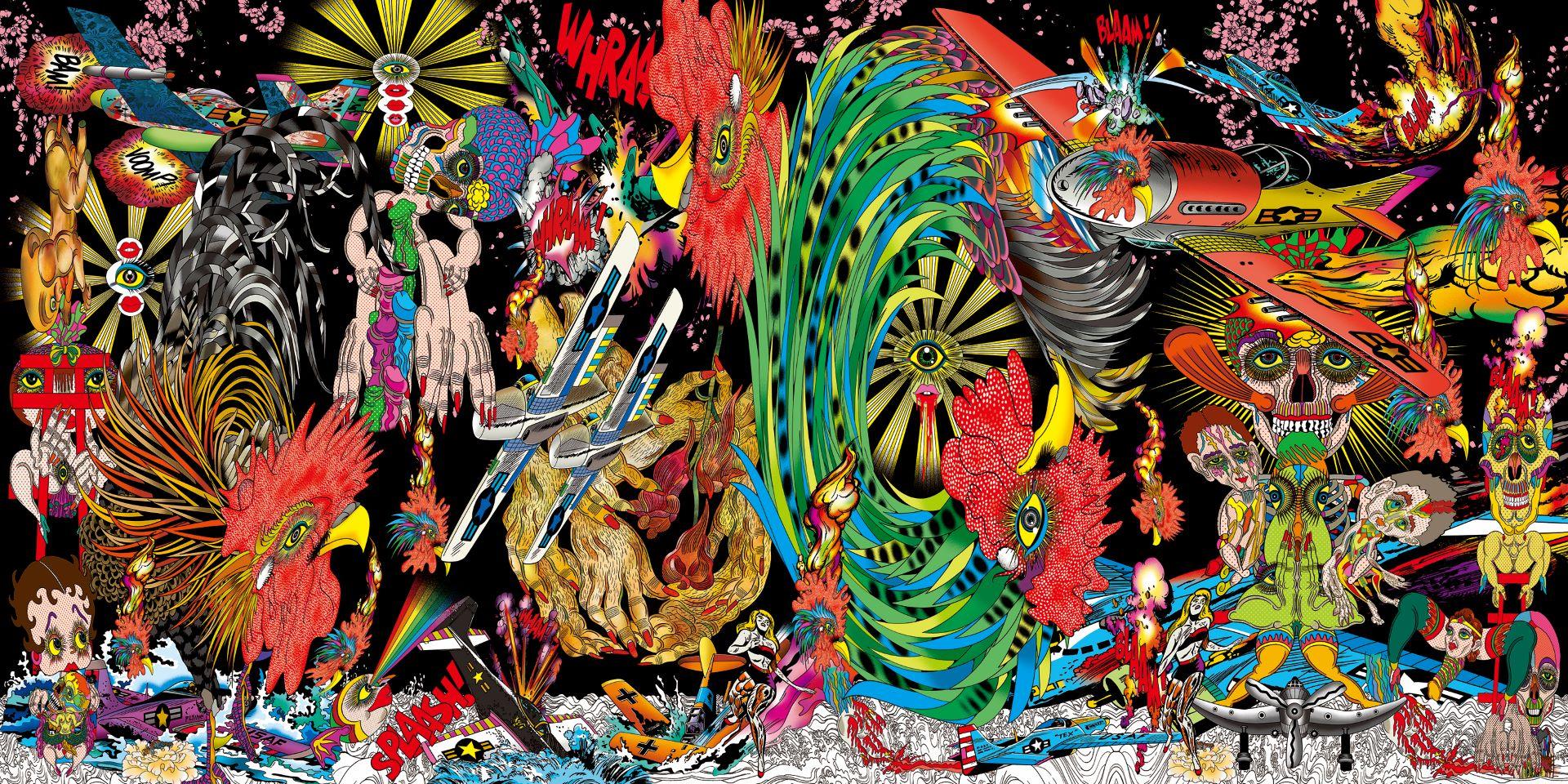
Keiichi Tanaami, The Story of Death and Rebirth, 2019
Pigmented ink, acrylic silkscreen medium, crushed glass, glitter, and acrylic on canvas
200×400 cm(4 canvases)
©Keiichi Tanaami / Courtesy of NANZUKA
Pleasure of Picasso – Mother and Child Series, 2020 – ongoing
As the COVID-19 pandemic swept the world, it also brought changes to Tanaami’s practice. With scheduled exhibitions and other plans disrupted, Tanaami began using some of his newfound free time to copy Pablo Picasso’s Mother and Child, a painting he has long admired. He initially intended to make about ten copies, but the number steadily grew, and to date he has produced over 500 works. Tanaami, who has said that constraints stimulate his creativity, has developed his own narrative over the course this series by incorporating diverse images into the basic format of Picasso’s Mother and Child. For Tanaami, this series is akin to the Buddhist practice of transcribing sutras, and it continues to be a part of his daily routine.

Keiichi Tanaami, Pleasure of Picasso – Mother and Child
2020/2021年
Acrylic on canvas
41×31.8×2 cm
©Keiichi Tanaami / Courtesy of NANZUKA
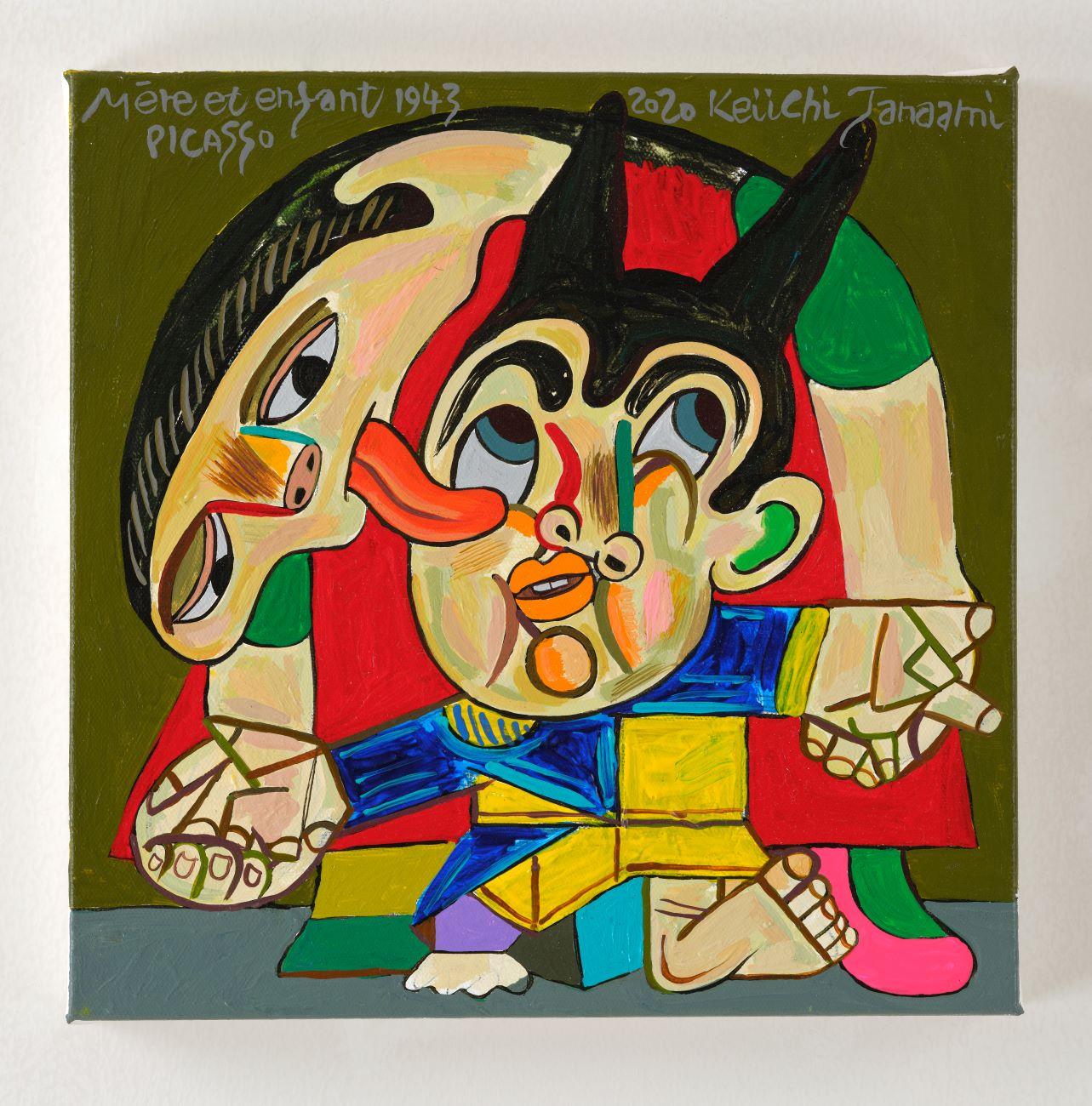
Keiichi Tanaami, Pleasure of Picasso – Mother and Child
2020/2021年
Acrylic on canvas
30×30×3.7 cm
©Keiichi Tanaami / Courtesy of NANZUKA
Inconceivable Body, 2019
This sculpture consists of a stack of faces, each with a powerful gaze that seems to penetrate the viewer. A complex amalgamation of skulls, spiders, chickens, goldfish, undulating pine trees and other imagery is synthesized into a single entity that appears to be thrumming with life force. Tanaami has described the bizarrely shaped creatures that he frequently portrays as people wounded in wars, and as embodiments of the fearless side of all human beings. Since the 2000s, he has been making sculptures inspired by Buddhist statues such as the Thousand-Armed Kannon, and he has spoken of an “enduring fascination with menacing, shape-shifting sacred icons.” This piece is among those resembling an aberrant Buddhist statue, depicting creatures from the Buddhist paradise of the Pure Land as envisioned by Tanaami.
|
Keiichi Tanaami, Inconceivable Body, 2019 |
Catalogue
Exhibition Catalogue
|
|
The exhibition catalogue includes a prologue by Keiichi Tanaami, an essay by Hiroko Ikegami (Art Historian, Professor at The Graduate School of Humanities, Osaka University), Sarah Suzuki (Associate Director, The Museum of Modern Art, New York), Julian Ross (Assistant Professor, Leiden University Center for the Arts in Society), Natsu Onodera (curator, the National Art Center, Tokyo), and Yuji Yamashita (Art Historian, Professor, Department of Art and Design, Meiji Gakuin University) and more.
Pages: 420
Language: Japanese, English
Price: 4,950 yen (incl.tax)
Size: 297×220 mm
Published by: SEIGENSHA Art Publishing, Inc.
Edited by: The National Art Center, Tokyo
List of Works
Credit
Organized by
The National Art Center, Tokyo; The Asahi Shimbun; Japan Arts Council; Agency for Cultural Affairs, Government of Japan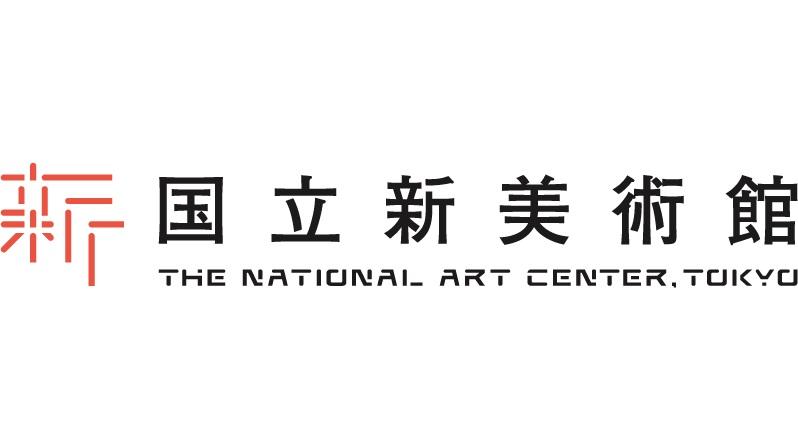
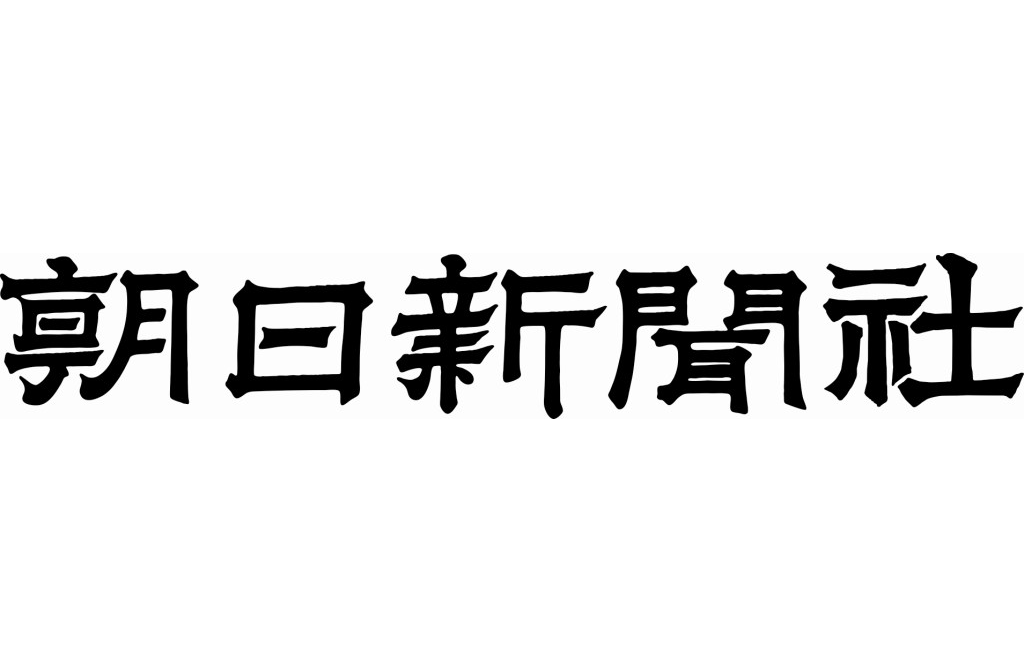

With the sponsorship of
Shueisha; adidas; MATTEL CREATIONS™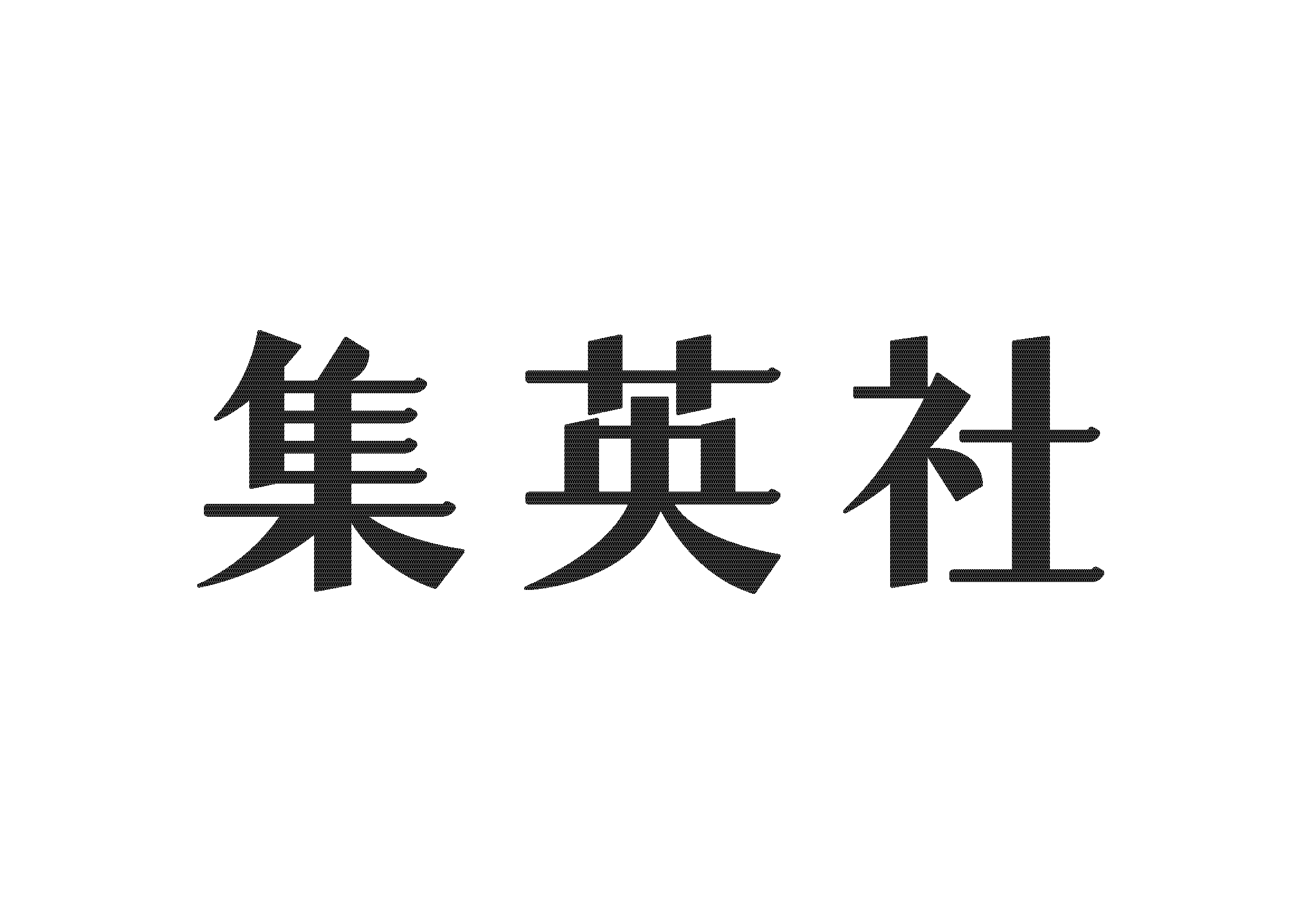


Production cooperation
Sony Music Entertainment
With the cooperation of
NANZUKA
With the support of
J-WAVE
movie
Symposium: Keiichi Tanaami at Present
The Memory about Keiichi Tanaami
Related books
A list of materials related to the exhibition that were introduced in the Art Library are available on the OPAC. Please click here to see the list on Past Exhibition-related Materials Exhibit page.

